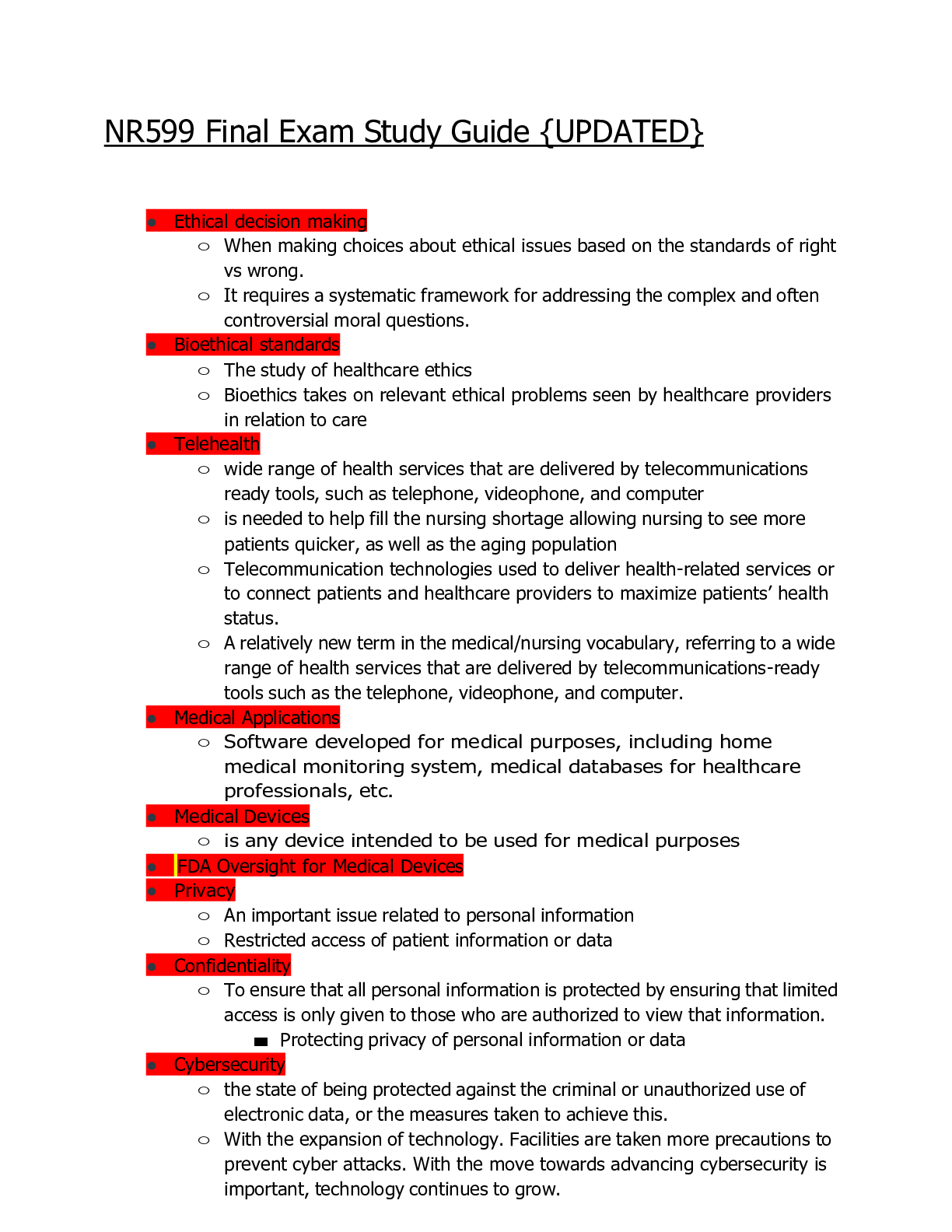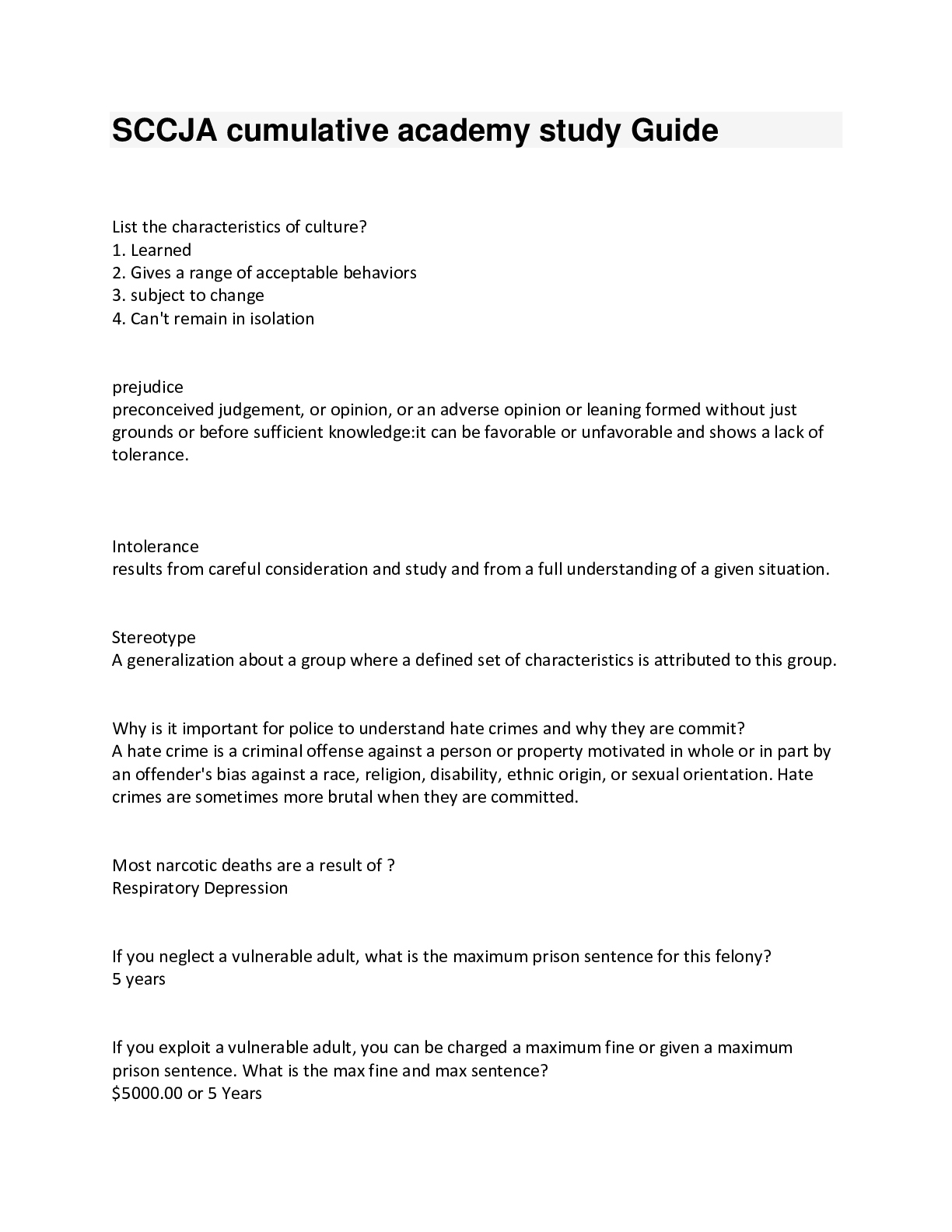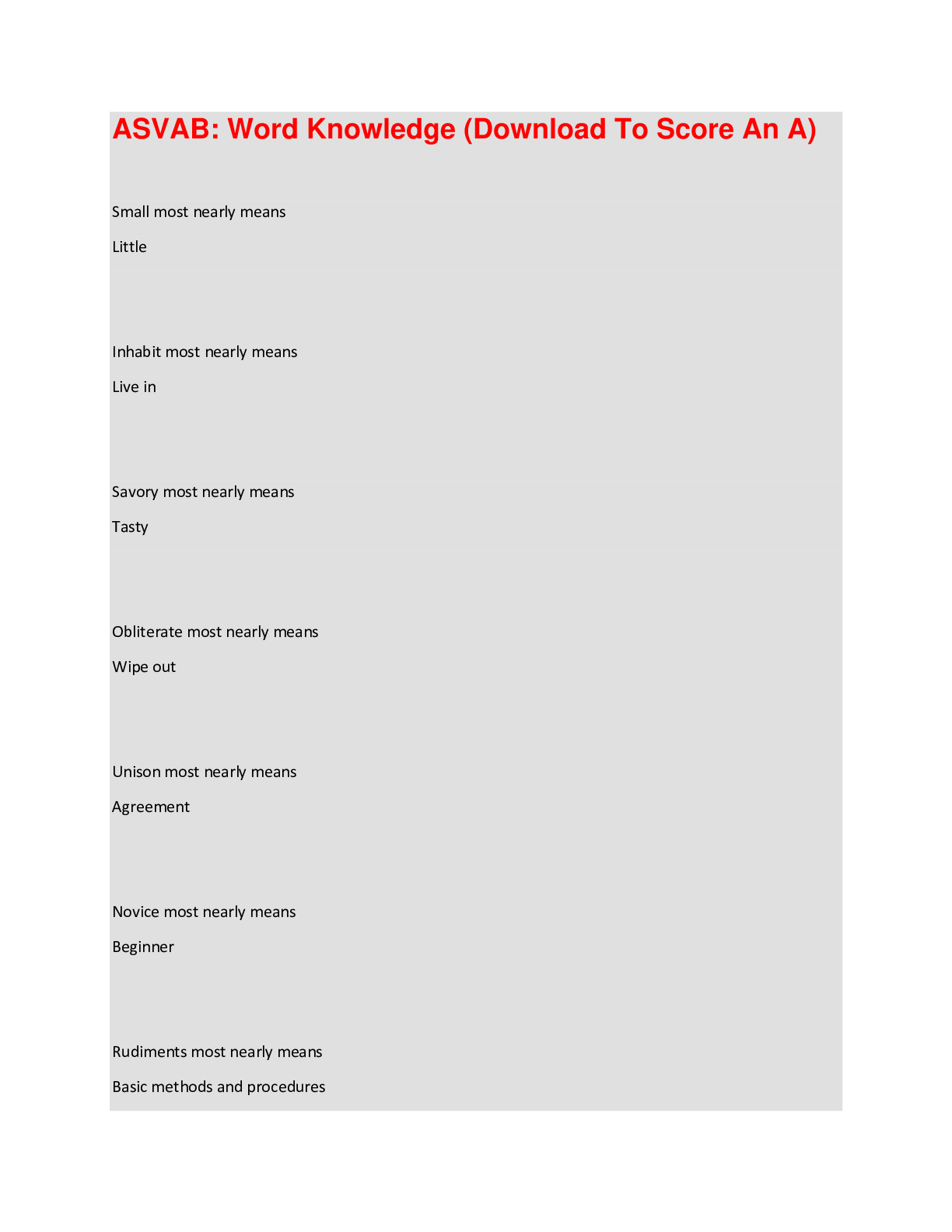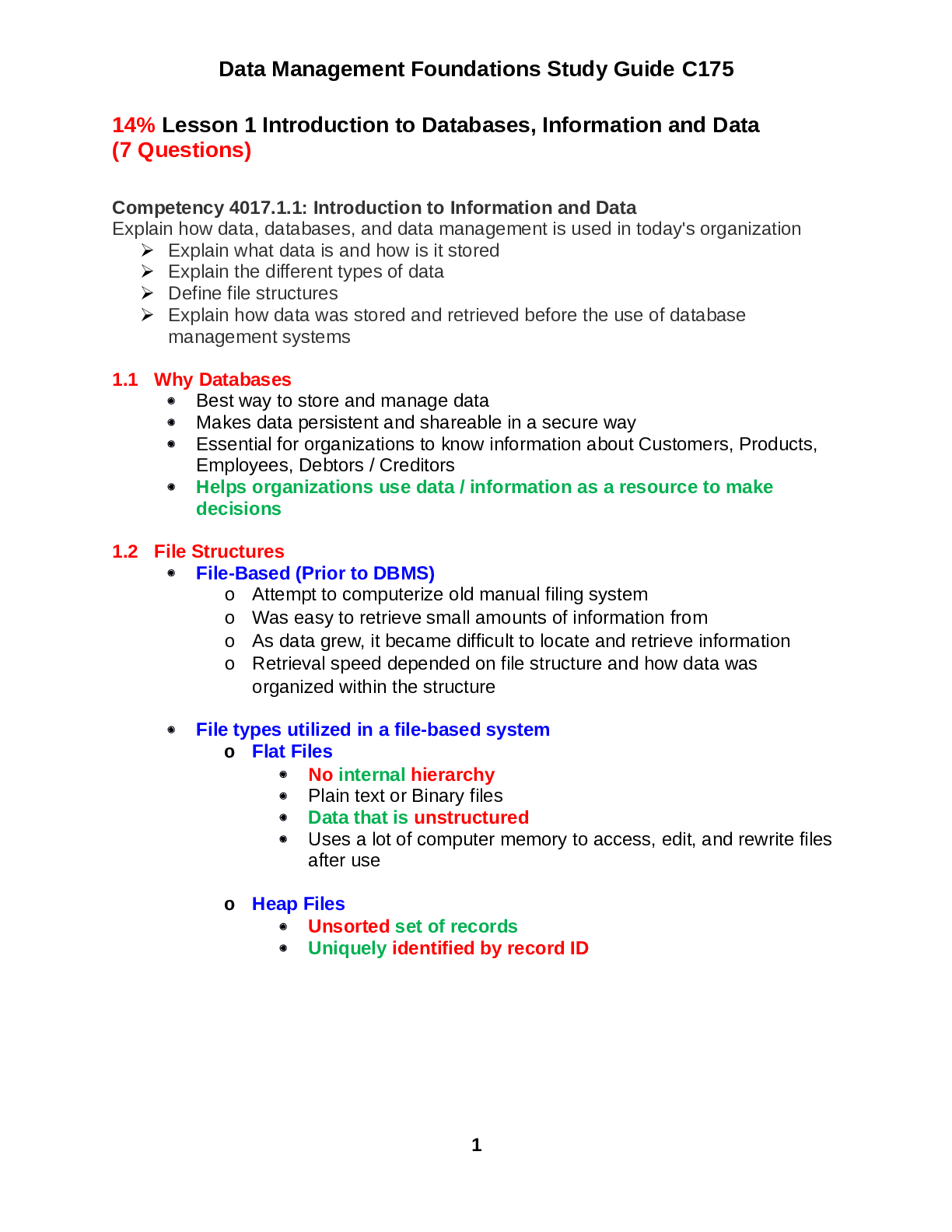*NURSING > STUDY GUIDE > NR-503 Week 8 Final Reviewer (Download To Score An A) (All)
NR-503 Week 8 Final Reviewer (Download To Score An A)
Document Content and Description Below
NR-503 Week 8 Final Reviewer (Download To Score An A) Week 5 1. How does culture influence the decisions a provider may make when selecting an intervention? 2. Explain how culture impacts provi... der attitudes? Does it? How will you assess your own attitudes about various cultures/races/groups? 3. Review the terms for this week and apply them to population health; for instance: cultural competence, cultural awareness, norms, values, Kleinman Explanatory Model, socioeconomic status, disparities, minorities, food dessert. o Culture - the practices, beliefs, values, and norms which can be learned or shared, and which guide the actions and decisions of each person in the group o Cultural competence - a dynamic, fluid, continuous process whereby an individual, system or health care agency find meaningful and useful care delivery strategies based on knowledge of the cultural heritage, beliefs, attitudes, and behavior of those to whom they render care. ▪ 4 principles of cultural competence – Caring is designed for the specific client. Care is based in the uniqueness of the person's culture and includes cultural norms and values. Care includes self-employment strategies to facilitate client decisions making to improve health behaviors. Care is provided with sensitivity and is based on the cultural uniqueness of clients. o Cultural awareness - Self-examination of one's own prejudices and biases toward other cultures. An in-depth exploration of one's own cultural/ethnic background o Cultural humility - A lifelong commitment to self-evaluation and self-critiques, redressing the power of imbalances in the patient- physician dynamic, developing mutually. Beneficial relationships o Cultural knowledge - Obtaining a sound educational foundation concerning the various worldviews of differences cultures. Obtaining knowledge regarding biological variations, disease and health conditions and variation in drug metabolism. o Cultural skill - Ability to collect culturally relevant data regarding the client's health history and presenting problem. Ability to conduct culturally based physician assessments. Conducting these assessments in a culturally sensitive manner. o Norms and values - Specific practices that guide their actions and decisions of each person in a group based on their culture. Can be either learned or shared. o Kleinman Explanatory Model - A set of questions the advanced practice nurse can use in order to assess the culture of a patient and proposes that individuals have vastly different notions of health and disease. o Socioeconomic Status - A measure that takes into account three interrelated dimensions: a persons income level, education level, and type of occupation. Some measures of socioeconomic status use only one dimension such as income. o Disparities - A higher burden of illness, injury, disability, or mortality experienced by one group in relation to another. ex. Socioeconomic, health, racial or ethnic o Miniorities - o Food dessert - Neighborhoods and communities that have limited access to affordable fresh and nutritious food o Ethnicity - the aggregate of cultural practices, social influences, religious pursuits, and racial characteristics shaping the distinctive identity of community 4. What are the social determinants of health? How does a provider integrate knowledge of these social determinants of health into their practice? Why are they important? o Things like poverty, education level, racism, income and poor housing that affect access to healthcare. Biology and genetics, individual behavior, social environment, physical environment, and health services. 5. Apply social justice theory to the provision of care; what does social justice mean when applied to health care? o The goal that all people will have equal opportunity to healthcare access and quality of healthcare will be the same 6. What data sources are used to assess determinants of health? o Chronic Disease Indicators. Level of data: state, territory, select large metropolitan areas. The Chronic Disease Indicators enable public health professionals and policy makers to retrieve state and selected metropolitan-level data for chronic diseases and risk factors. o Interactive Atlas of Heart Disease and Stroke. Level of data: national, state, territory, county. The Interactive Atlas of Heart Disease and Stroke enables online county-level mapping of heart disease and stroke by race/ethnicity, gender, and age group. Maps can show social and economic factors and health services for the United States, specific states, or territories. o National Center for HIV/AIDS, Viral Hepatitis, STD, and TB Prevention Atlas. Level of data: national, state, select territories. The Atlas provides interactive maps, graphs, tables, and figures showing geographic patterns and time trends of the reported occurrence of the following diseases: HIV, AIDS, viral hepatitis, tuberculosis, chlamydia, gonorrhea, and primary and secondary syphilis. The data are based on nationally notifiable infectious diseases in the United States and can be used to examine disparities. o National Environmental Public Health Tracking Network. Level of data: national, state, county. The Tracking Network is a system of integrated health, exposure, and hazard information and data from a variety of national, state, and city sources. Maps, tables, and charts with data about environmental indicators (e.g., particulate matter in the air) are available. o The Social Vulnerability Index. Level of data: census tract. The Social Vulnerability Index uses U.S. census variables at tract level to help local officials identify communities that may need support in preparing for hazards, or recovering from disaster. Social vulnerability refers to the resilience of communities when confronted by external stresses on human health, stresses such as natural or human-caused disasters, or disease outbreaks. Reducing social vulnerability can decrease both human suffering and economic loss. o Vulnerable Populations Footprint ToolExternal. Level of data: state, county, city, census tract. The Vulnerable Populations Footprint Tool creates maps and reports that identify geographic areas with high poverty rates and low education levels—two key social determinant indicators of population health. Thresholds for target areas are adjustable, allowing the tool to be used in geographic areas where regional rates may be higher or lower than the national average. (Free registration required to log in to this tool.) Week 6 7. Integrate risk / screening as it applies to genetics? How, what methods are used to screen for health conditions that may have genetic connections? What guidelines support evidence-based decision making in the area of genetics? 8. What is genetic risk assessment? How is it determined? 9. Explore and integrate genetic terminology, for example: Genomics, pharmacogenomics, genetic epidemiology. Also, refer to HP2020. o Genomics - The study of all genes in the human genome as well as their interaction with other genes, the individual’s environment, and the influence of cultural and psychosocial factors. o Pharmacogenomics - Medication efficacy, toxicity, and drug interaction based on genetic variations o Genetic epidemiology - 10. What are the components of a genetic risk assessment? 11. Can you discuss the interplay (connection) between genetics and the environment, how do they influence one another? Do they? 12. What is the Genetics Nondiscrimination Act? o The Genetic Information Nondiscrimination Act (GINA) of 2008 protects Americans from discrimination based on their genetic information in both health insurance (Title I) and employment (Title II). Title I amends the Employee Retirement Income Security Act of 1974 (ERISA), the Public Health Service Act (PHSA), and the Internal Revenue Code (IRC), through the Health Insurance Portability and Accountability Act of 1996 (HIPAA), as well as the Social Security Act, to prohibit health insurers from engaging in genetic discrimination. Week 7 13. Can you discuss the types of outbreaks at a population health level? o Phase 1—None of the current viruses circulating in animals have been reported to cause infection in humans. o Phase 2—An animal-based influenza virus is known to have caused infection in humans and is considered a potential pandemic threat. o Phase 3—An animal- or human-animal-based virus has caused some clusters of cases in people, but has not caused human-to-human transmission that is significant enough to cause community-level outbreaks. o Phase 4—Human-to-human transmission of an animal or human-animal virus is causing community outbreaks and sustained disease. This is a significant shift in risk and any country with such an outbreak should consult with WHO. o Phase 5—There is human-to-human spread of the virus in at least two countries. This phase means that pandemic is imminent and that community action and implementation of planned mitigation procedures is needed. o Phase 6—This is the pandemic phase, characterized by outbreaks in more than one WHO defined region in addition to all Phase 5 criteria (WHO, 2009) o Category 1—case fatality ratio of less than 0.1% and fewer than 90,000 U.S. deaths. Category 2—0.1%-0.5% case fatality ratio and 90,000-450,000 U.S. deaths. Category 3- 0.5%—1% case fatality ratio and 450,000-900,000 U.S. deaths. Category 4—1-2% case fatality ratio and 900,000-1.8 million U.S. deaths. Category 5—greater than 2% case fatality ratio and more than 1.8 million U.S. deaths (CDC, 2014). 14. How is the epidemiological triangle related to pandemics, outbreaks? 15. If you were to explain "disaster epidemiology" to a colleague or nursing student, what would you say? 16. What is the WHO? What do the SDG's (formerly MDG'S) mean? o - No poverty, Zero hunger, Good health and wellbeing, Quality education, Gender equality, Clean water and sanitation, Decent work and economic growth, Peace, justice and strong institutions. o The Sustainable Development Goals (SDGs), otherwise known as the Global Goals, are a universal call to action to end poverty, protect the planet and ensure that all people enjoy peace and prosperity. Goals resulting from a UN-led effort to end extreme poverty by focusing on 17 key indicators, the top five of which are no poverty, zero hunger, good health, quality education, and gender equality, with key benchmarks for 2030. o MDGs - The UN's creation of eight goals for economic development and social progress in 2000. Members agreed to reach the goals by 2015. ▪ Eradicate extreme poverty and hunger. Achieve universal primary education. Promote gender equality and empower women. Reduce child mortality. Improve maternal health. Combat HIV/AIDS, malaria, and other diseases. Ensure environmental sustainability. Develop a global partnership for development 17. Connect social justice theory to the implications of outbreaks. o Social justice theory - The goal that all people will have equal opportunity to healthcare access and quality of healthcare will be the same 18. What is the history of the World Health Organization? o 1945: charter of the United Nations; article calling for establishment of health agency with wide powers o 1946: UN representatives created and ratified the constitution of WHO o 1948: constitution went into force and WHO began work\ o The World Health Organization (WHO) is a specialized agency of the United Nations that is concerned with international public health. It was established on 7 April 1948, and is headquartered in Geneva, Switzerland. The WHO played a leading role in the eradication of smallpox. Its current priorities include communicable diseases, in particular HIV/AIDS, Ebola, malaria and tuberculosis; as well as the mitigation of the effects of non- communicable diseases such as sexual and reproductive health, development, and aging; nutrition, food security and healthy eating; occupational health; substance abuse; and driving the development of reporting, publications, and networking. 19. Be sure to review the articles: Angelini (2017) and Kurth (2017): What are said to be some of the noticed health effects of climate change? Can you speak to the "Call to Action" elements/content? o Call to action - It falls to nurses and midwives, the most numerous and arguably most patient-centered component of the health workforce, to assume a leadership role in addressing planetary health. Leadership begins with educating ourselves, students, staff, patients, and communities. Engagement in political and policy processes are needed-and can take many forms. Even small measures may have impact. Local level sustainability and readiness is meaningful at one's university, hospital, and or health system levels. Learn, Communicate, Find common ground. 20. How do you assess an area's resources and its relationship to the health of a region? Week 8 21. How do ethics and public policy intersect? o Ethics - practices with compassion and respect committed to patient, family, community, and population promoting, advocating, and protecting the rights, health, and safety of the patient. o Public Health Policy - collected laws, regulations, and approaches taken to make a decision including a wide range of topics including health care reform, insurance reform with an eye to individuals who are not covered by an employer or a group, and the prevention and control of communicable diseases. 22. What influence do you as a provider have regarding public policy? What ethical obligation do you believe you have? 23. How is risk reduction, assessment, and outcomes related to public health policy? o Risk reduction - the health protection when individuals participate in behaviors that enable then to react to actual or potential threats o Assessment - the gathering of information about a patient's physiological, psychological, sociological, and spiritual status. o Public Health Policy - collected laws, regulations, and approaches taken to make a decision including a wide range of topics including health care reform, insurance reform with an eye to individuals who are not covered by an employer or a group, and the prevention and control of communicable diseases. 24. Where is the intersection of: epidemiology, population health, public policy and social justice and vulnerable populations? 25. Are you able to define the key ethical terms and apply them to population health? For instance, ethics, fairness and social justice. o Ethics - practices with compassion and respect committed to patient, family, community, and population promoting, advocating, and protecting the rights, health, and safety of the patient. o Fairness - the state, condition, or quality of being fair or free of bias or injustice o Social justice - justice in terms of the distribution of wealth, opportunities, and privileges within a society. Definitions 1. Unexposed Incidence - incidence of new cases of disease in persons who were not exposed 2. Unexposed Incidence Equation - number unexposed with disease / total number of unexposed 3. Relative Risk - risk of disease in one group versus another; risk of developing disease after exposure; 1 = no risk 4. Relative Risk Equation - # exposed with disease/total of all exposed // # unexposed with disease/total all unexposed 5. Odds Ratio - measure of exposure and disease outcome commonly used in case control studies 6. Odds Ration Equation - R(exposed)/1-R(exposed) / R(unexposed)/1-R(unexposed) 7. Prevalence - current number of all affected persons with a specific disease present in a population at a specific time period 8. Prevalence Equation - (persons with disease / total pop) x1000 9. Primary Prevention - preventing initial development of disease; action taken to prevent development of a disease in person who is well, does not have disease 10. Secondary Prevention - early detection of existing disease to reduce severity and complications (or) identifying people in whom disease process has already begun, but who have not developed symptoms 11. Tertiary Prevention - reducing impact of disease (or) preventing complications in those who have already developed signs and symptoms of an illness, have been diagnosed 12. Pandemic - excessive occurrence of disease present globally 13. Incidence of Disease - measure of risk; total number in population with disease divided by total number of populations [Show More]
Last updated: 1 year ago
Preview 1 out of 7 pages

Also available in bundle (2)

NR 503 Week 8 Final Quiz (Collection)
NR 503 Week 8 Final Quiz (Submitted October 2022) Question: (CO 1, 5) How does implicit bias impact access and provision of healthcare? Question: (CO 1, 3, 7) How does disaster epidemiology inform...
By A+ Solutions 1 year ago
$18
4

NR 503 Population Health, Epidemiology And Statistical Principles Entire Course Week 1 – 8 BUNDLED (100% CORRECT ELABORATIONS)
NR 503 Week 1 Quiz: Acknowledgement Practice Quiz: Academic Writer NR-503 Week 1 Discussion: Exercise and Discussion Questions from Curley Textbook: Chapter 1, Exercise 1.5 NR 503 Week 1 Discussion:...
By A+ Solutions 1 year ago
$14.5
37
Reviews( 0 )
Document information
Connected school, study & course
About the document
Uploaded On
Dec 01, 2022
Number of pages
7
Written in
Additional information
This document has been written for:
Uploaded
Dec 01, 2022
Downloads
0
Views
55










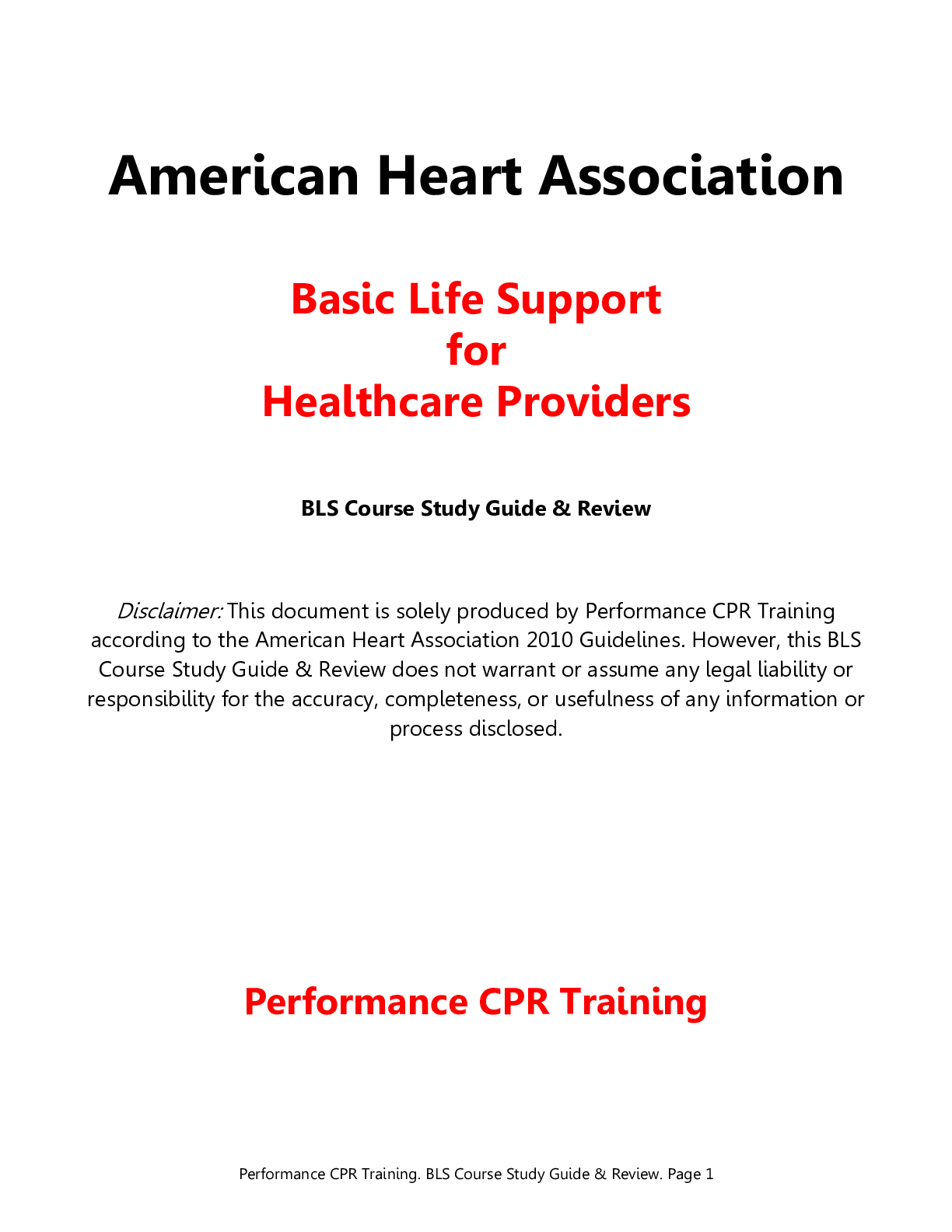
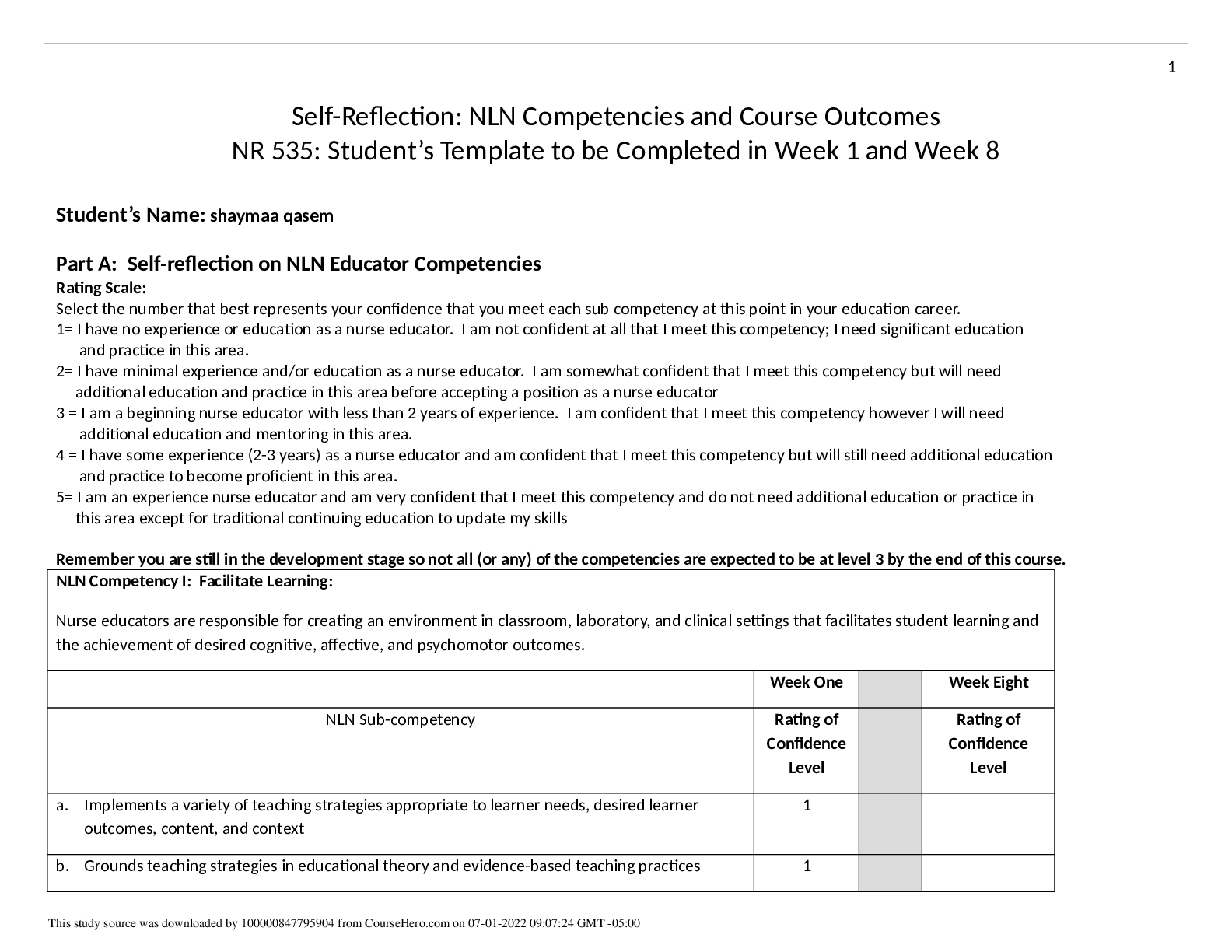
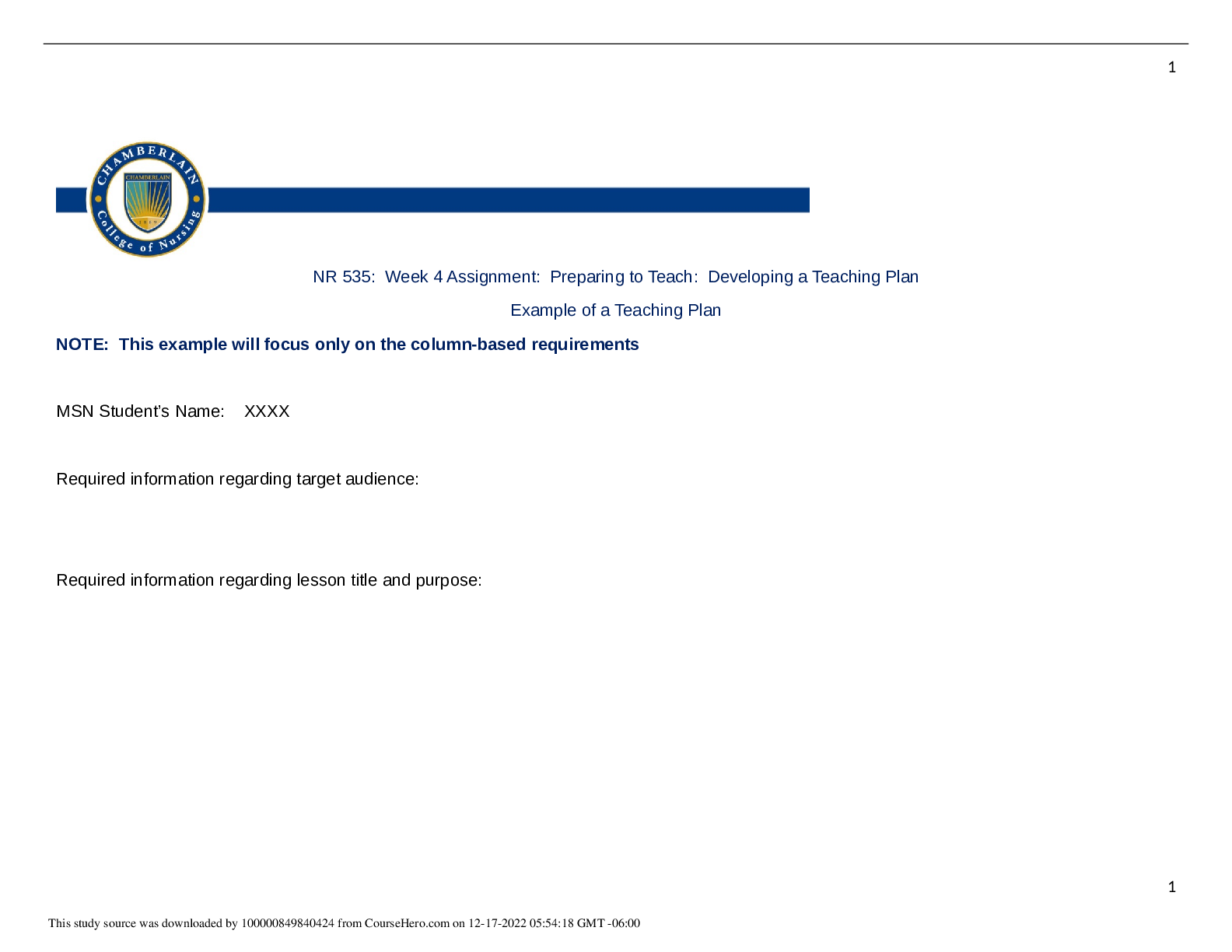
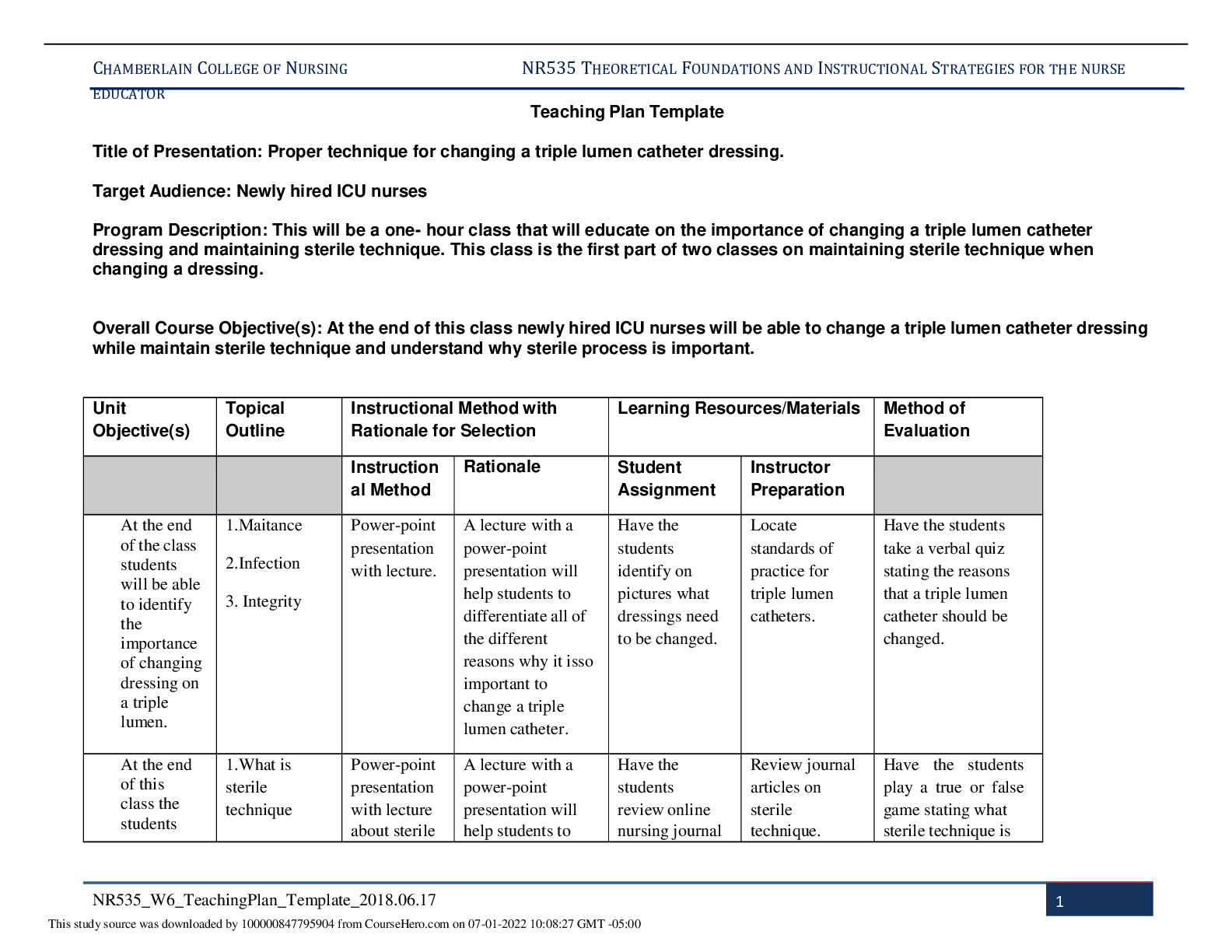
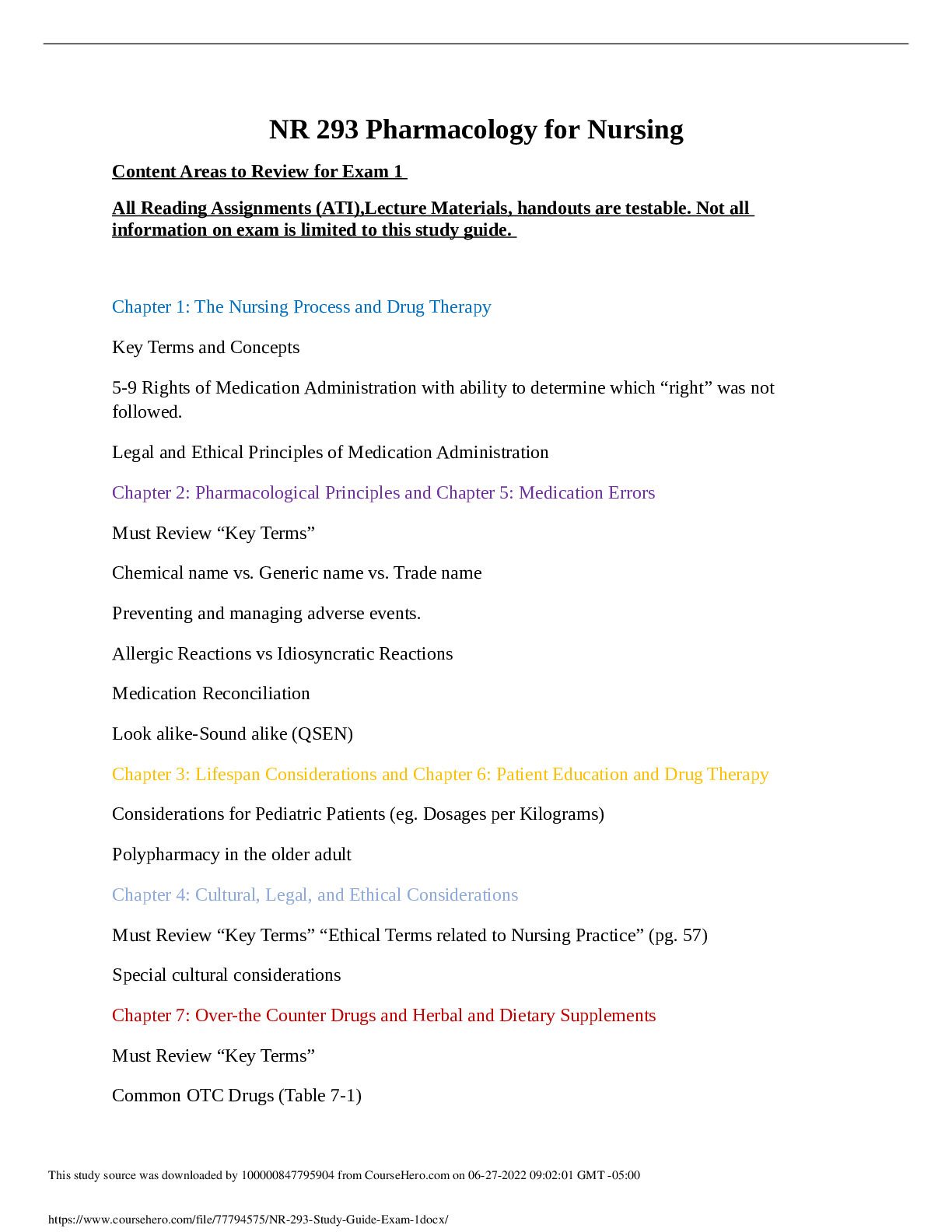
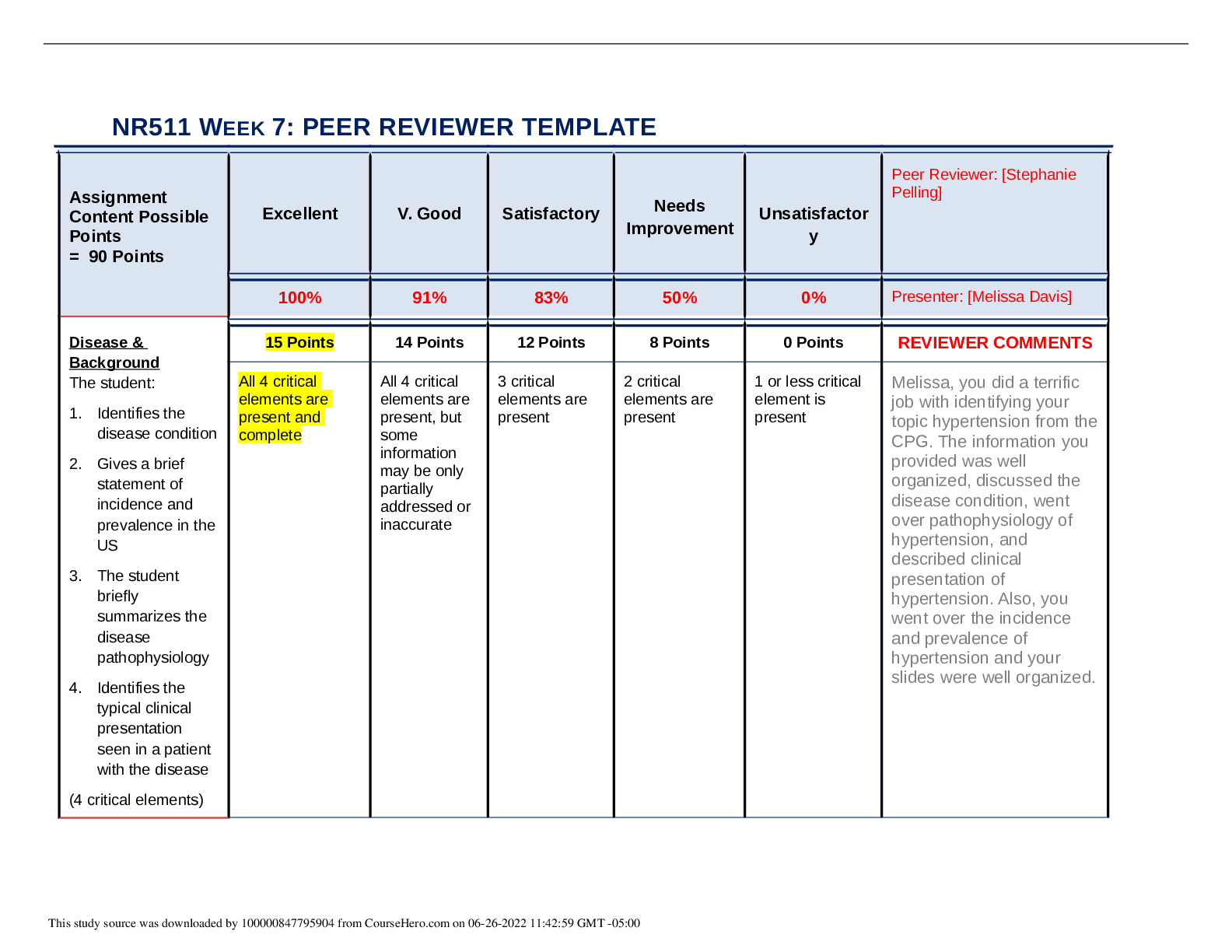

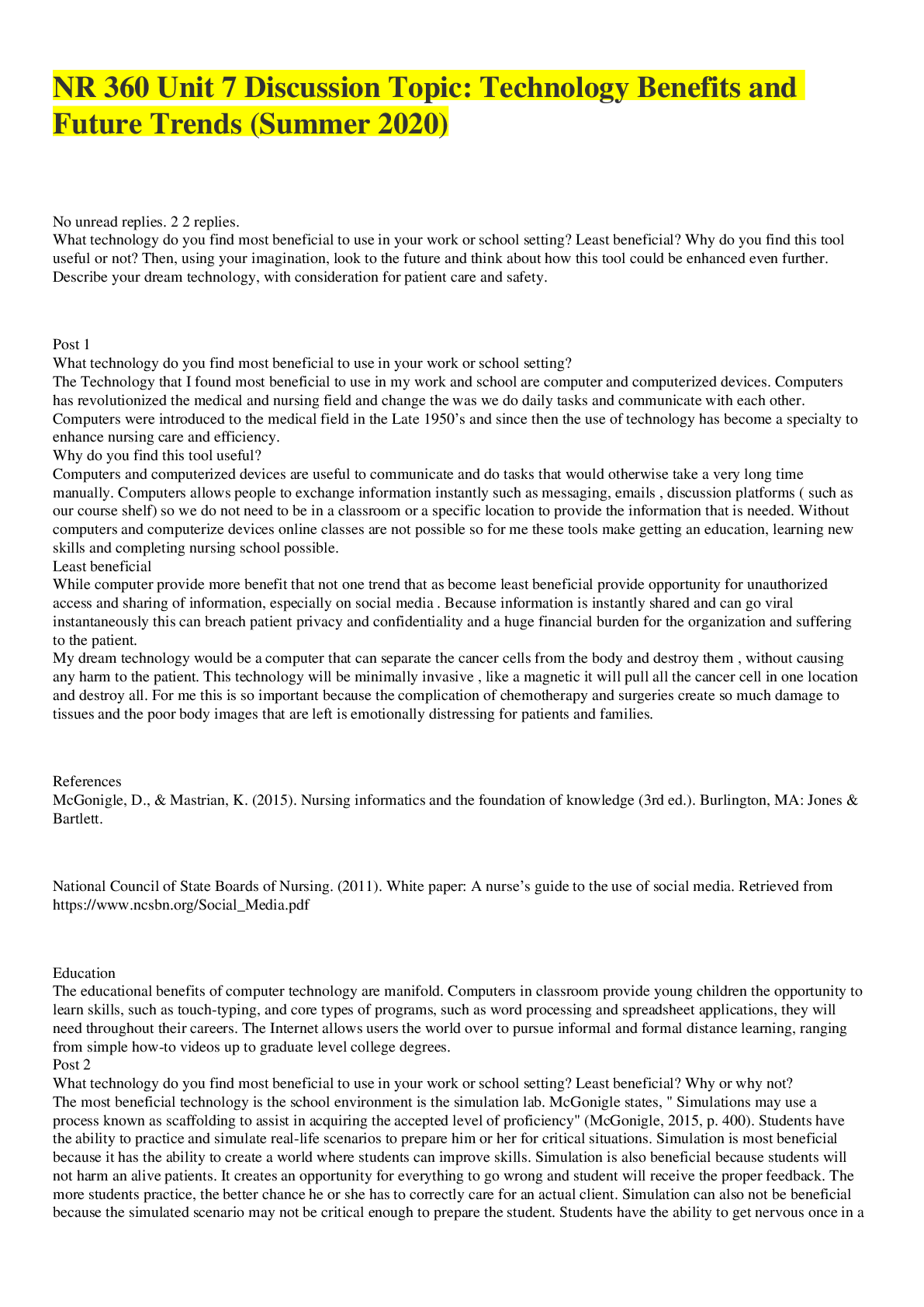
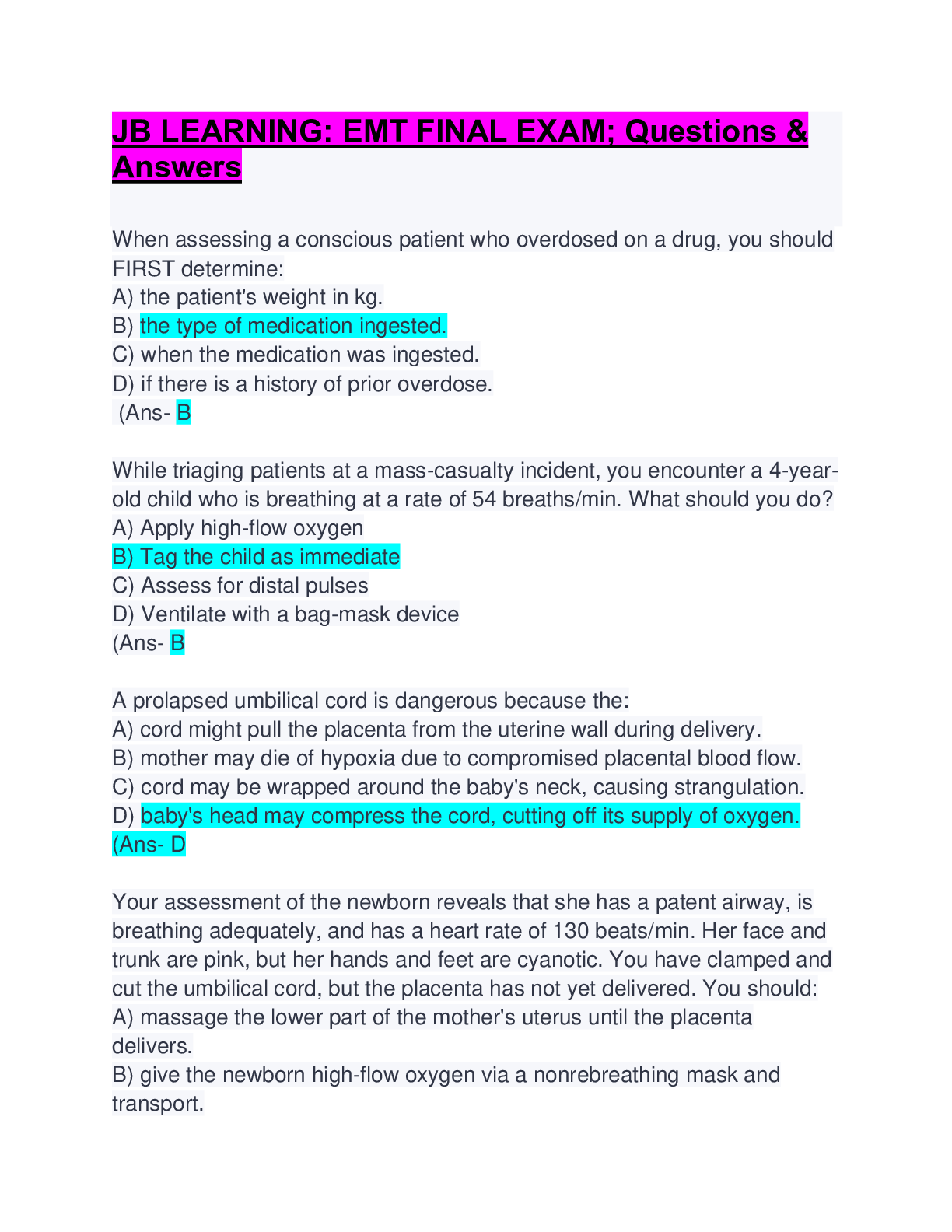
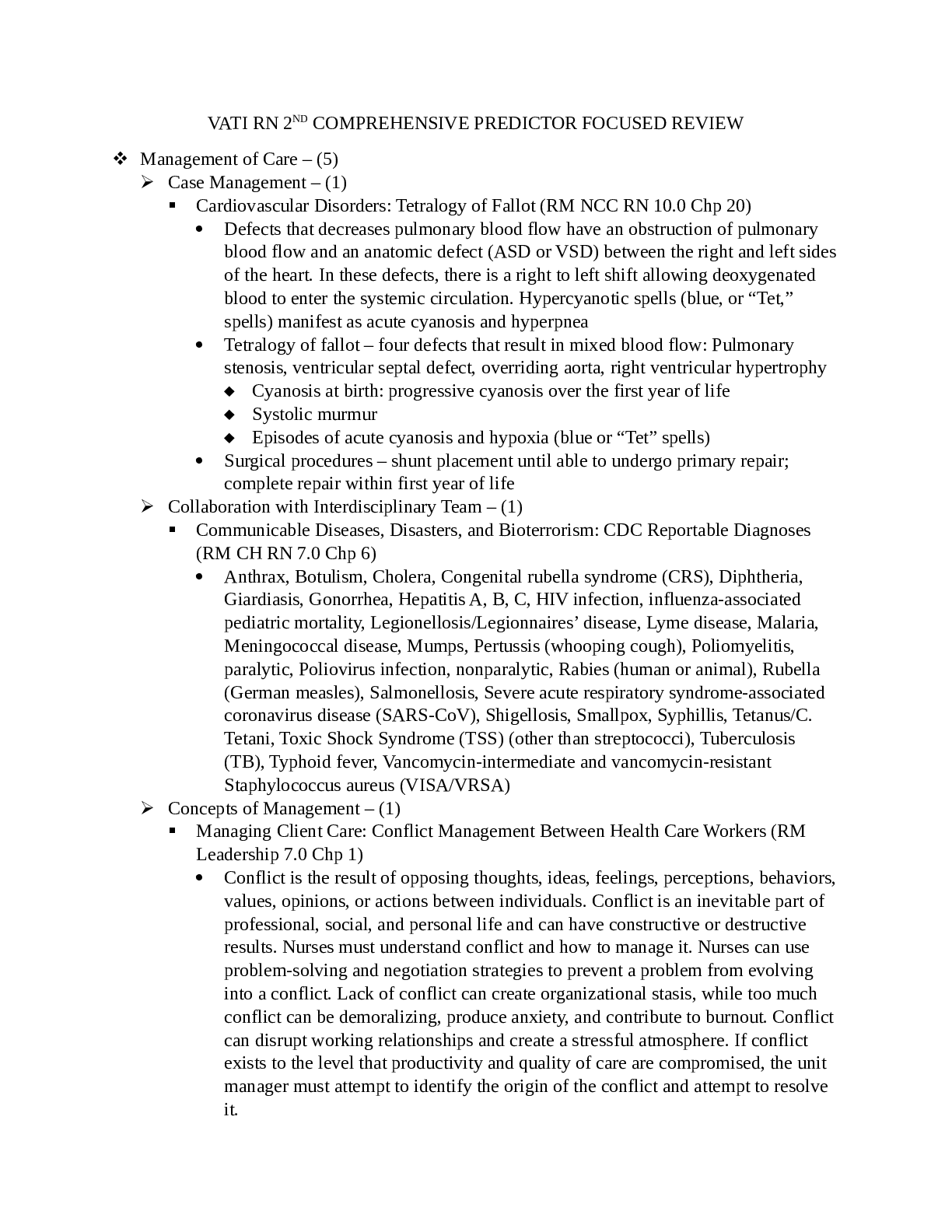
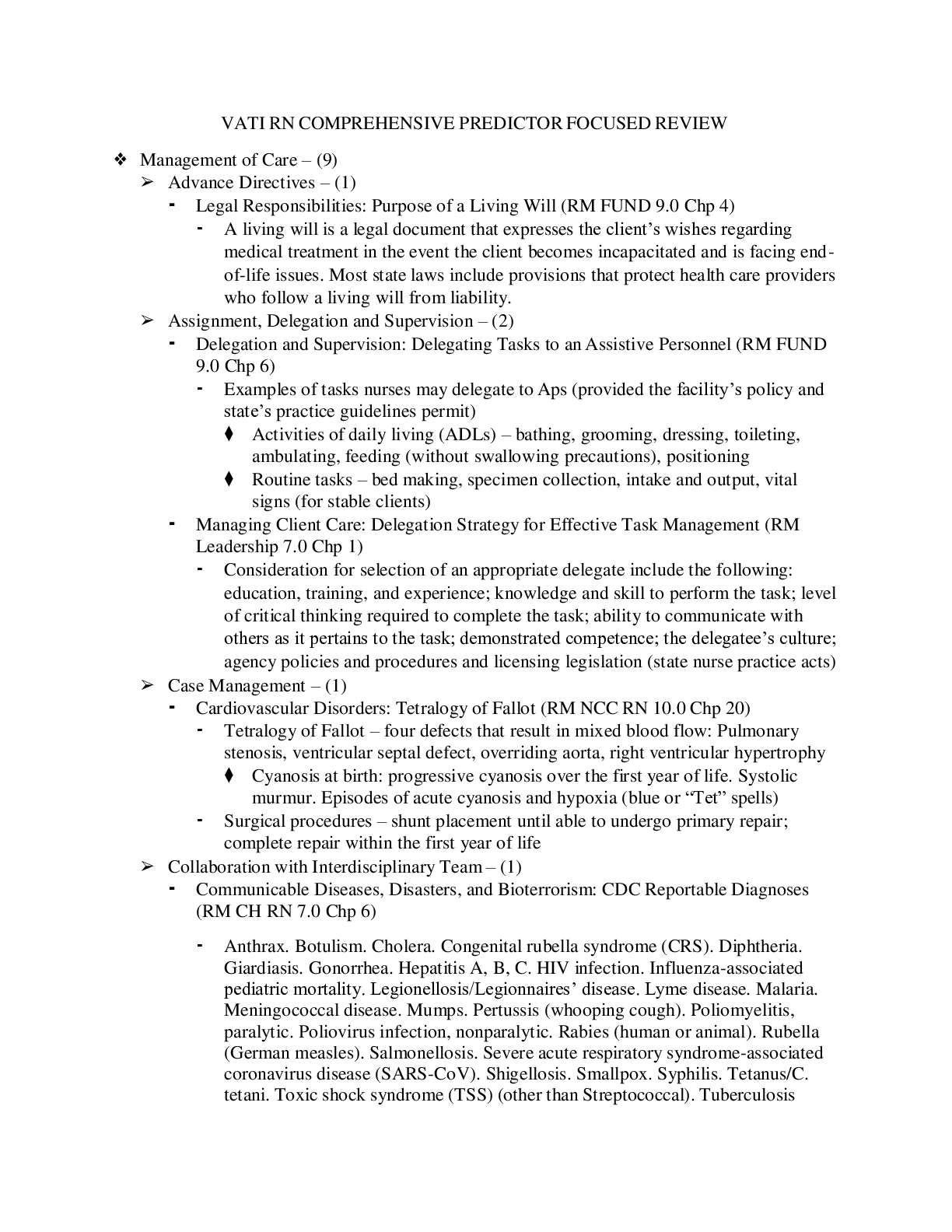

 2021.png)
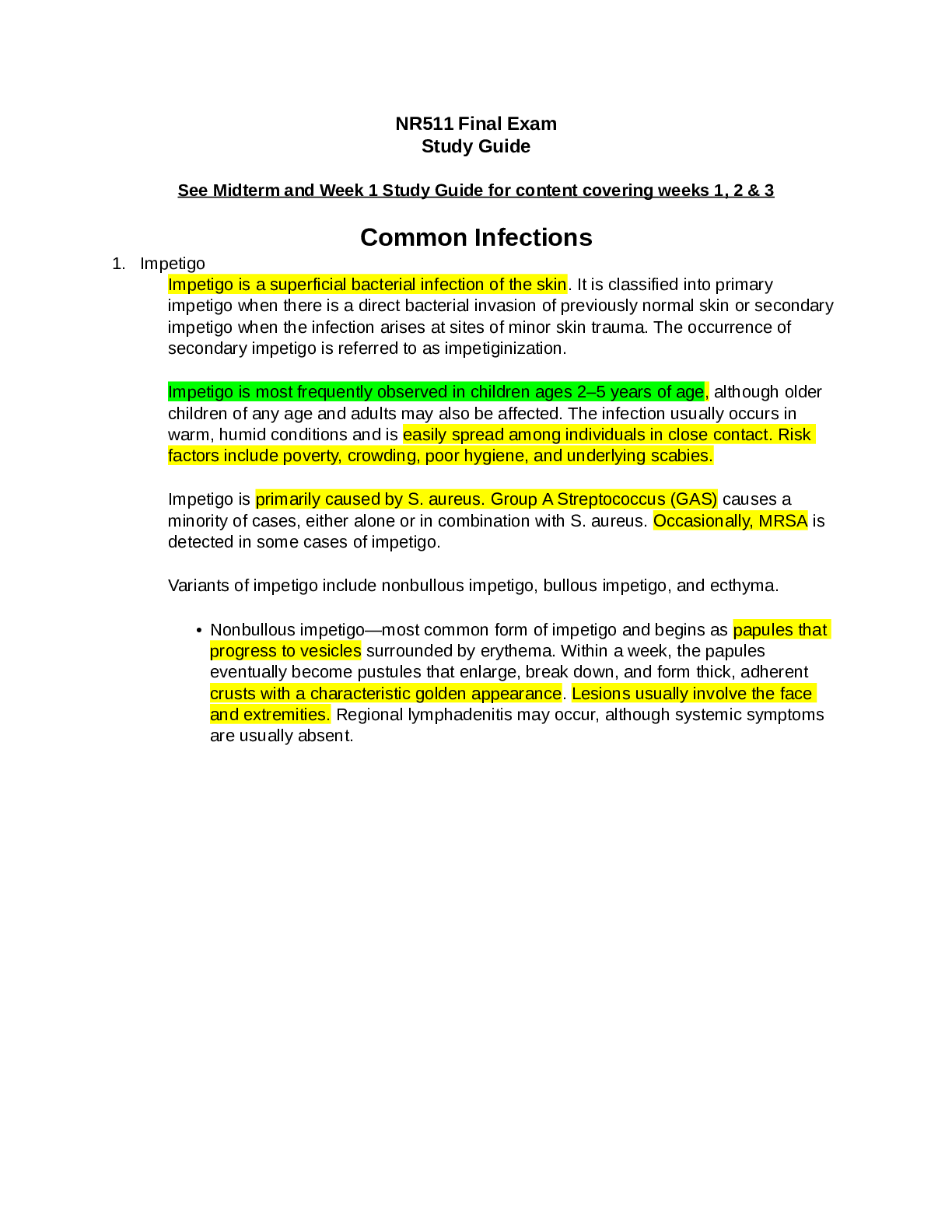
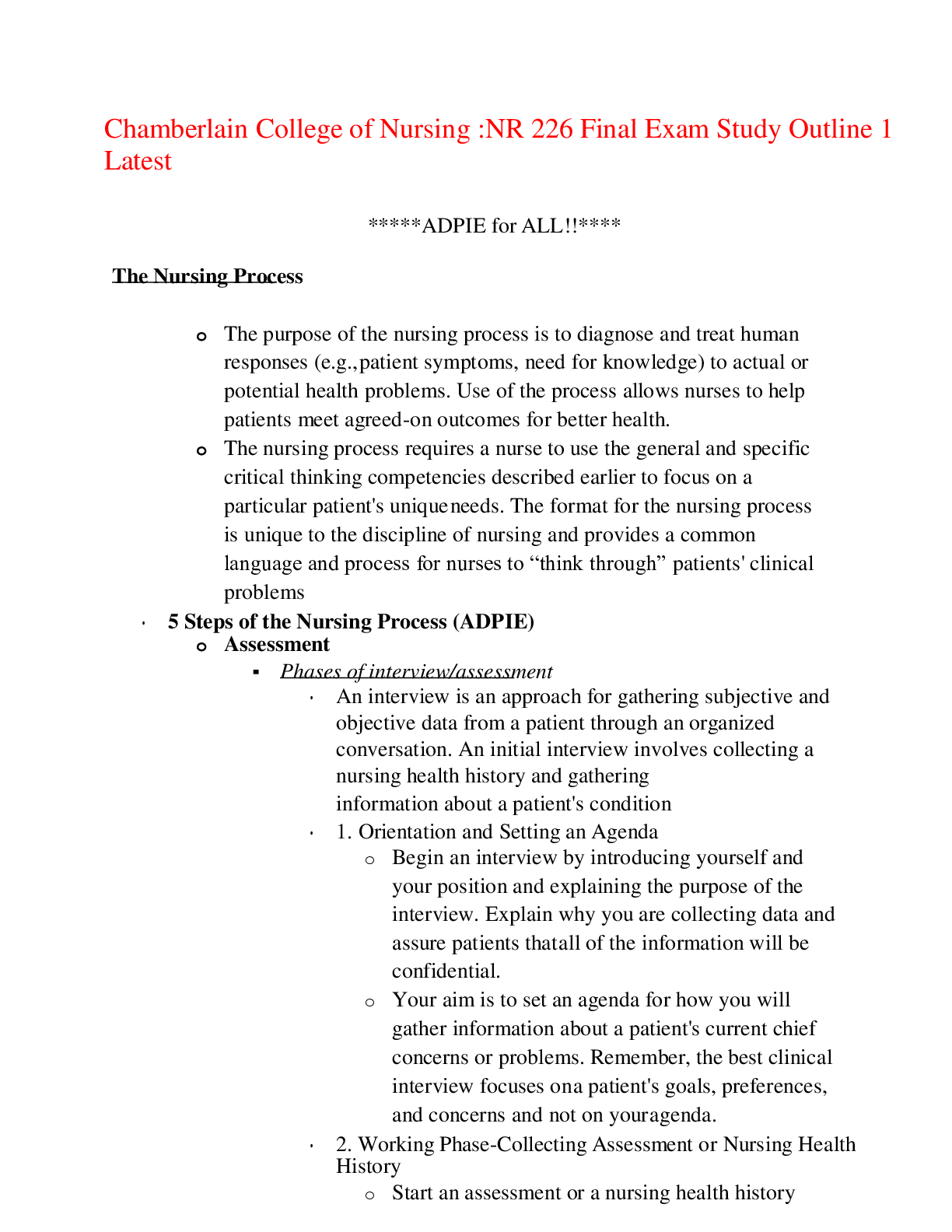
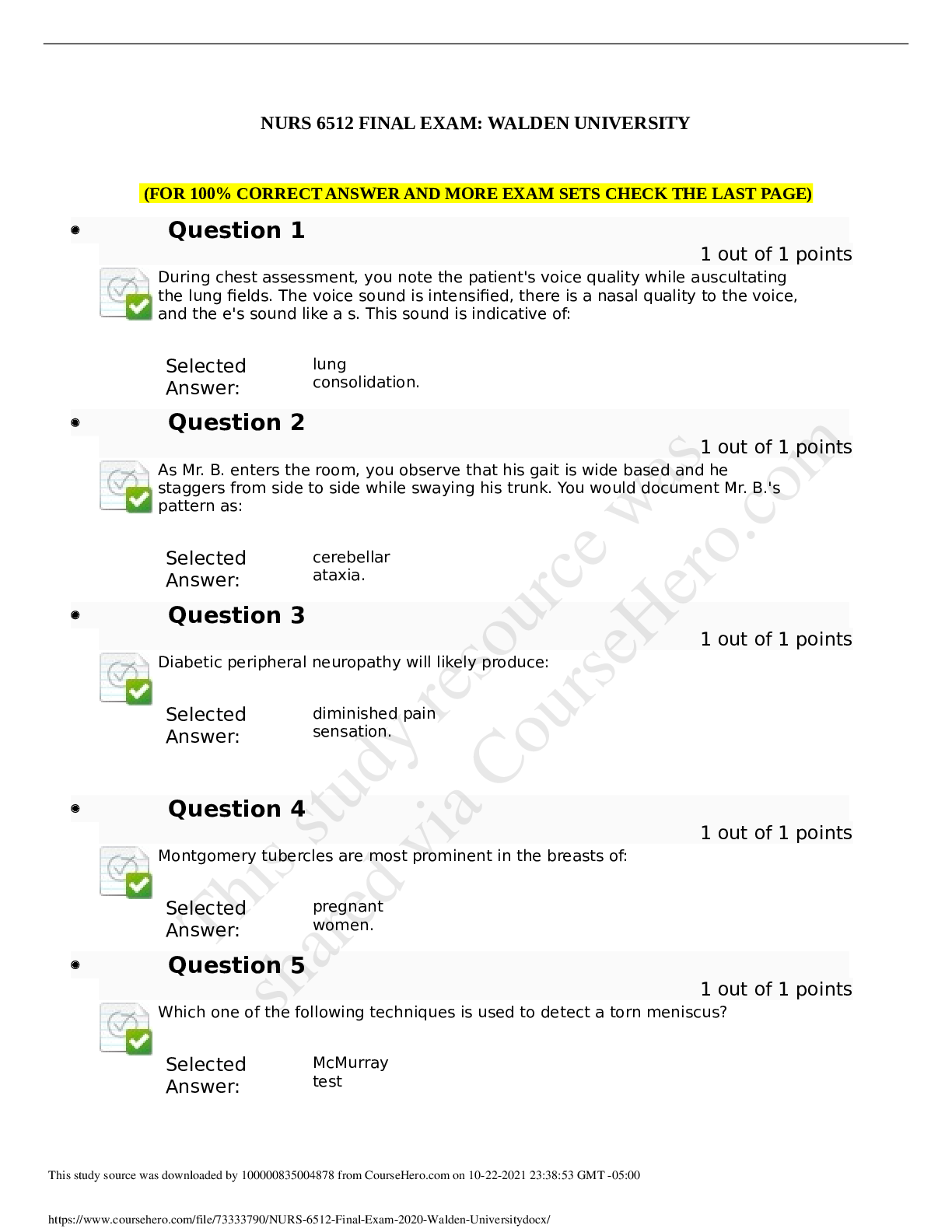
.png)
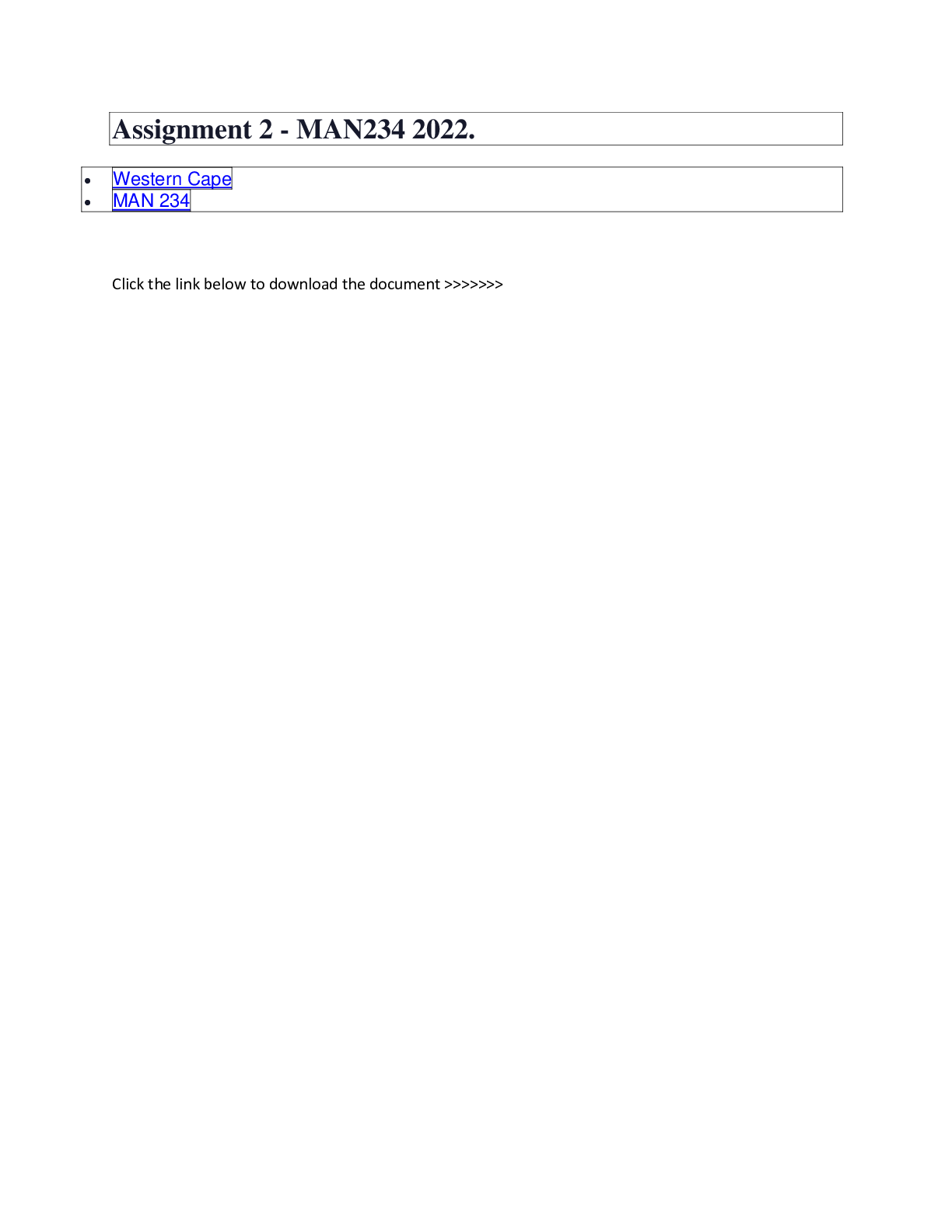
.png)


